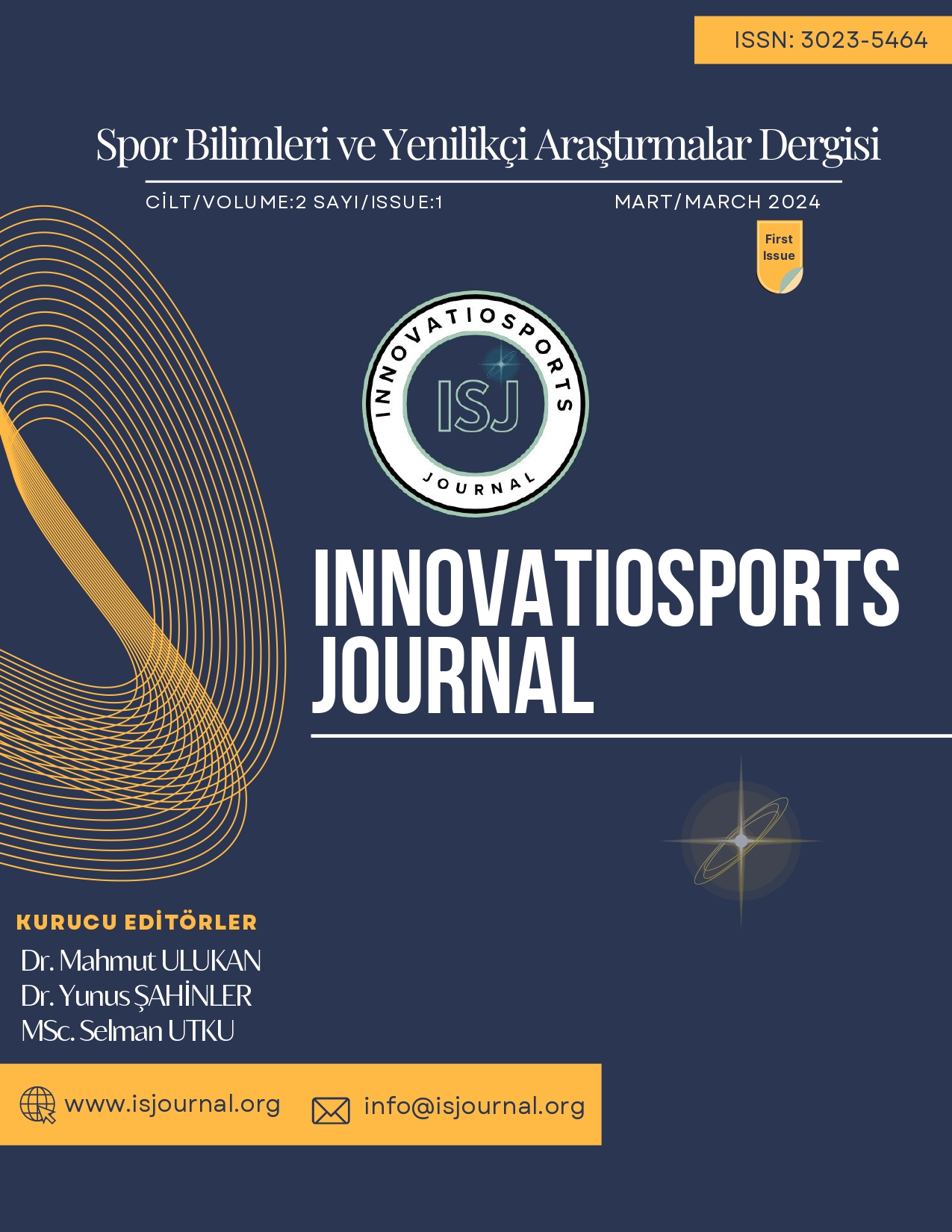Examination of Some Biomotoric Characteristics of 8-9-Year-Old Children New to Sports
DOI:
https://doi.org/10.5281/zenodo.10885598Keywords:
sports, training, biomotorics, performanceAbstract
The objective of this study was to assess the impact of regular training programs on the biomotor development of newly engaged 8-9-year-old children in sports. The research examined test results on biomotor characteristics, including flexibility, agility, vertical jump, and 20-meter sprint. The study included 25 participants, 14 males and 11 females, aged between 8 and 9, who engaged in sports for 1 hour, twice a week. The study participants had an average age of 8±0.7 years, a height of 128±36 cm, and a body weight of 27±12 kg. The data were analyzed using SPSS 29.00 statistical software package, including normality tests, frequency analyses, and paired sample t-tests. The study found significant differences in flexibility, agility, and the 20-meter sprint test among children who were newly engaged in sports. However, the study did not observe significant changes in areas such as vertical jump and throwing a ball backward. These results emphasize the effectiveness of training programs in improving the biomotor characteristics of children who are newly engaged in sports. The study also highlights the necessity of long-term and specific training for the development of specific skills.
References
Anıl, F., Erol, E., & Pulur, A. (2001). Pliometrık çalışmaların 14-16 yaş grubu bayan basketbolcuların bazı fiziksel ve fizyolojik parametreleri üzerine etkisi. Gazi Beden Eğitimi ve Spor Bilimleri Dergisi, 6(2), 19-26.
Arslan, F., Kaplan, T., & Sanioğlu, A. (2007, Kasım 9-11). İlköğretim okullarındaki 8-13 yaş grubu öğrencilerin yetenek ve performans profillerinin tespiti [IV. Uluslararası Akdeniz Spor Bilimleri Kongresi]. Antalya, Türkiye.
Asadi, A. (2013). Effects of in-season short-term plyometric training on jumping and agility performance of basketball players. Sport Sciences for Health, (9), 133-137.
Atasoy, H. (2018). Yüzme antrenmanlarının; 8-10 yaş performans grubu yüzücülerinin serbest stil dereceleri ile bazı antropometrik ve motorik özellikler üzerindeki etkisinin incelenmesi (Yayın No. 503367) [Yüksek Lisans tezi, İstanbul Gelişim Üniversitesi]. Ulusal Tez Merkezi.
Bozkurt, S., Bal, M., Kırbayır, B., & Erkut, O. (2016, Kasım 1-4). Fiziksel etkinlik kartlarının yer değiştirme ve dengeleme hareketleri gelişimine etkisi; Beykoz ilçesi pilot ilkokul uygulaması [14. Uluslararası Spor Bilimleri Kongresi]. Antalya, Türkiye.
Can, S. (2007). 10 -12 yaş grubundaki erkek tenisçiler masa tenisçiler aynı yaş grubu sedanterlerin reaksiyon zamanlarının karşılaştırılması (Yayın No. 225748) [Yüksek Lisans tezi, Gazi Üniversitesi]. Ulusal Tez Merkezi.
Çelik, A., Günay, E., & Aksu, F. (2013). 7-9 Yaş grubu ilköğretim öğrencilerinin fiziksel ve motorik özelliklerinin değerlendirilmesi. DEU Tıp Dergisi, 27(1), 7-13.
Davaran, M., Elmieh, A., & Arazi, H. (2014). The effect of a combined (plyometric-sprint) training program on strength, speed, power and agility of karate-ka male athletes. Research Journal of Sport Sciences, 2(2), 38-44.
Diker, G., & Müniroğlu, S. (2016). 8-14 yaş grubu futbolcuların seçilmiş fiziksel özelliklerinin yaş gruplarına göre incelenmesi. SPORMETRE Beden Eğitimi ve Spor Bilimleri Dergisi, 14(1), 45-52. https://doi.org/10.1501/Sporm_0000000283
Ekmekçi, R., & Ekmekçi, Y. A. (2010). Spor pazarlaması. Pamukkale Journal of Sport Sciences, 1(1), 23-29.
Gençlik ve Spor Bakanlığı (GSB) (2024). Sporcu yetiştirme daire başkanlığı türkiye sportif yetenek taraması ve spora yönlendirme programı genel tarama test ve ölçümler. Retrieved February 10, 2024, from https://sportifyetenektaramasi.gsb.gov.tr
Gül, G. K. Seyrek, E., & Sugurtin, M. (2006, Kasım 3-5). 10-12 yaş atletizm spor eğitimi alan ve almayan erkek çocuklar arasındaki bazı antropometrik ve motorik özelliklerin karşılaştırılması [9. Uluslararası Spor Bilimleri Kongresi]. Muğla, Türkiye.
Jovanovic, M., Sporis, G., Omrcen, D., & Fiorentini, F. (2011). Effects of speed, agility, quickness training method on power performance in elite soccer players. The Journal of Strength & Conditioning Research, 25(5), 1285-1292.
Khodaei, K., Mohammadi, A., & Badri, N. (2017). A comparison of assisted, resisted, and common plyometric training modes to enhance sprint and agility performance. The Journal of Sports Medicine and Physical Fitness, 57(10), 1237-1244.
Koçyiğit, B., & Şahinler, Y. (2019). 12-14 yaş tenisçilerde teknik antrenman programlarının bazı biyomotorik ve teknik gelişimleri üzerine etkilerinin araştırılması. Beden Eğitimi ve Spor Bilimleri Dergisi, 21(3), 85-95.
Orhan, S., Pulur, A., & Erol, A. E. (2008). İp ve ağırlıklı ip çalışmalarının basketbolcularda bazı fiziksel ve fizyolojik parametrelere etkisi. Fırat Üniversitesi Sağlık Bilimleri Dergisi, 22(4), 205-210.
Özmen, Ö. (1999). Çağdaş sporda eğitim üçgeni (2.baskı). Bağırgan Yayınevi. Ankara.
Sporis, G., Milanovic, L., Jukic, I., Omrcen, D., & Molinuevo, J. S. (2010). The effect of agility training on athletic power performance. Kinesiology: International Journal of Fundamental and Applied Kinesiology, 41(1), 65-72.
Şahan, H. (2007). Üniversite ögrencilerinin sosyallesme sürecinde spor aktivitelerinin rolü (Yayın No. 211047) [Yüksek Lisans tezi, Selçuk Üniversitesi]. Ulusal Tez Merkezi.
Tamer, K. (2000). Sporda fiziksel performansın ölçülmesi ve değerlendirilmesi (2. baskı). Bağırgan Yayınevi. Ankara.
Thomas, K., French, D., & Hayes, P. R. (2009). The effect of two plyometric training techniques on muscular power and agility in youth soccer players. The Journal of Strength & Conditioning Research, 23(1), 332-335.
Downloads
Published
How to Cite
Issue
Section
License
Copyright (c) 2024 InnovatioSports Journal

This work is licensed under a Creative Commons Attribution 4.0 International License.


